human clippers and their suitability for grooming dogs
Human clippers and their effectiveness in grooming dogs are a common topic amongst pet owners. Can you use them for your furry friend? Let’s dive into the suitability of human clippers for dog grooming.
- Human clippers are generally not suitable for dogs.
- Dog clippers have sharper blades than human ones, which can make a huge difference in the quality of cut achieved.
- If you choose to use human clippers, they need to be heavy-duty and high-powered; otherwise, they will not be able to handle your dog’s thick fur or coarse hair and could pull and tug at it, causing pain and discomfort.
- Pet-specific clippers have specific purposes, such as quiet operation that won’t spook dogs that might scare away from loud noise. Some breeds are more sensitive than others about this subject.
- Lastly, using the proper clipper blade size is crucial to get an even cut for your pet’s desired length. Therefore, please use specified blades rather than unprofessional alternatives during grooming your beloved furry pet.
While some may argue that human clippers can be used on dogs with a higher maintenance schedule due to overheating if not cleaned regularly, choosing appropriate animal grooming devices ensure longer-lasting results by reducing stress and pain inflicted upon the animal.
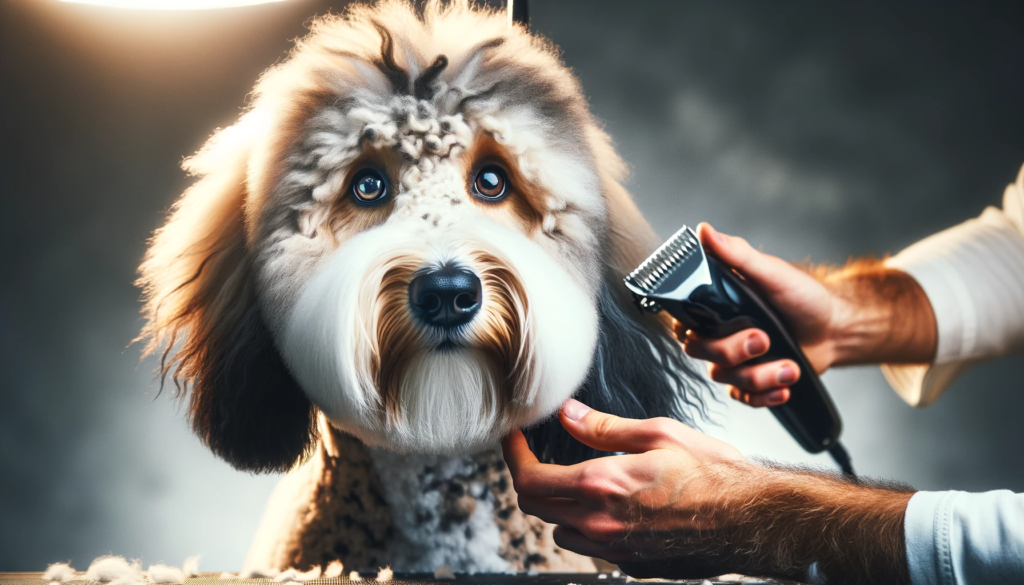
Potential risks and benefits of using human clippers on dogs
When it comes to grooming our furry friends, many dog owners ask the question if human clippers are suitable for their pets. While it may seem convenient to use what we already have at home, there are potential risks and benefits of using human clippers on dogs that need to be considered.
Benefits:
- Cost Savings: Using human clippers can save money as they’re often already in most homes.
- Availability: They’re easily accessible and can be found in most households.
Risks:
- Skin Irritation: Human clippers may cause discomfort or skin irritation as they’re not designed for pet fur.
- Inefficiency: They may not be as effective at cutting through thick, dense dog hair.
Possible Alternatives:
- Pet-specific Clippers: These are designed specifically for pet fur, ensuring safety and efficiency.
- Professional Grooming Services: Consider taking your pet to a professional groomer for a safe and thorough grooming experience.
Be cautious when using any tool that was not designed specifically for dogs, as it could result in unwanted injuries or discomfort. It is important that you research extensively before making decisions when it comes to your animal’s safety.

Factors to consider when choosing a clipper for dogs
Choosing the Right Clippers for Your Canine Companion
When it comes to grooming your furry friend, having the right clipper makes all the difference. Here are some important factors to consider when selecting dog clippers.
- Blade Size: Choose a blade size that is appropriate for your dog’s coat length and texture.
- Speed: Clippers with multiple speed settings allow you to adjust the speed based on your dog’s individual needs.
- Noise Level: Some dogs may become anxious or frightened by loud noises, so choose a clipper with a low noise level if this is a concern.
- Ergonomics: Comfortable grip and lightweight design can minimize hand fatigue and ensure better control.
It is also important to consider other features like corded versus cordless, battery life, and ease of cleaning. Taking the time to research and choose the right clipper will make grooming sessions more comfortable for both you and your furry friend.
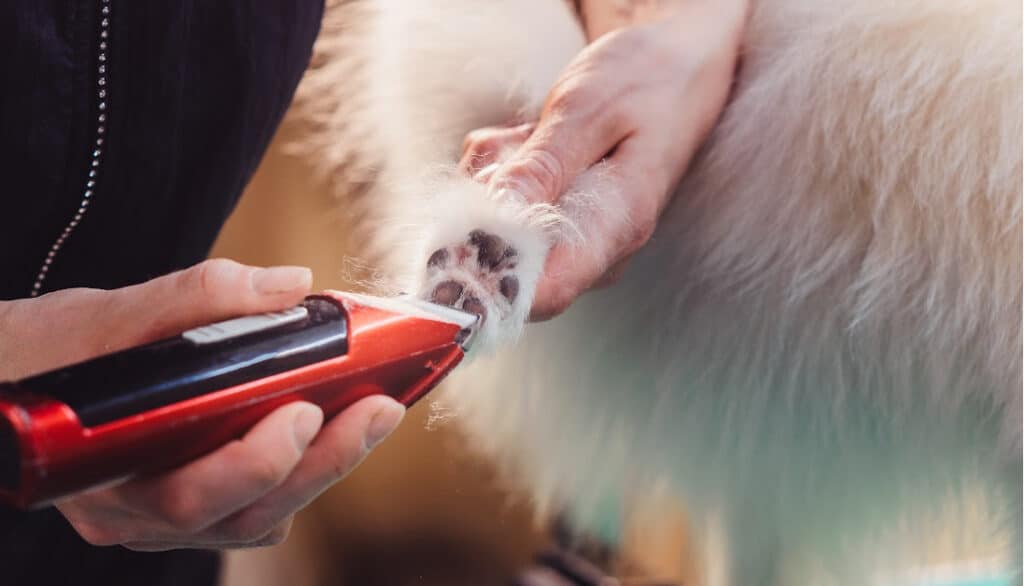
Best Clippers for Grooming Dogs
To find the perfect clippers for grooming your furry friend, explore the Best Clippers for Grooming Dogs section with an overview of different types, features to look for, and the top five best clippers for dogs in the market. Discover which clipper type offers the ideal features for your dog grooming needs.
Overview of different types of clippers available for dogs
Different types of dog clippers available in the market have unique features that cater to various coats, sizes and needs of pets.
| Type | Description | Usage |
| Corded Clippers | Need electricity to operate with a powerful motor, generates high-speeds, and provides high precision. | Suitable for long hair breeds or dogs with thick and tangled coats. |
| Cordless Clippers | Battery powered make less noise and vibration than corded ones which help not to scare dogs while making grooming sessions convenient. They are portable, easy to handle. | Suitable for all breed’s shorter haircuts depending on their battery timings. |
| Silent Clippers | Ideal for noise-sensitive pets or those prone to anxiety that cannot bear loud sounds while getting groomed. The lower vibrations keep them calm during grooming sessions. | Suits smaller dogs as it doesn’t have too much power but designed solely for trimming ears, legs, muzzle areas. |
While selecting a perfect clipper that works efficiently is an essential factor- Knowing the types of clippers will allow you to pick the best one that suits your furry friend’s grooming requirements -the length of their coat, texture and breed.
It is worth considering the blades’ sharpness as this has a significant effect on a clipper’s performance and lifespan. Proper cleaning & lubricating clippers after every usage increase durability.
Overall, for complete pet grooming success, having the right clipper and accessories will make a lot of difference in the quality and quantity of your pet’s coat trimming experience.
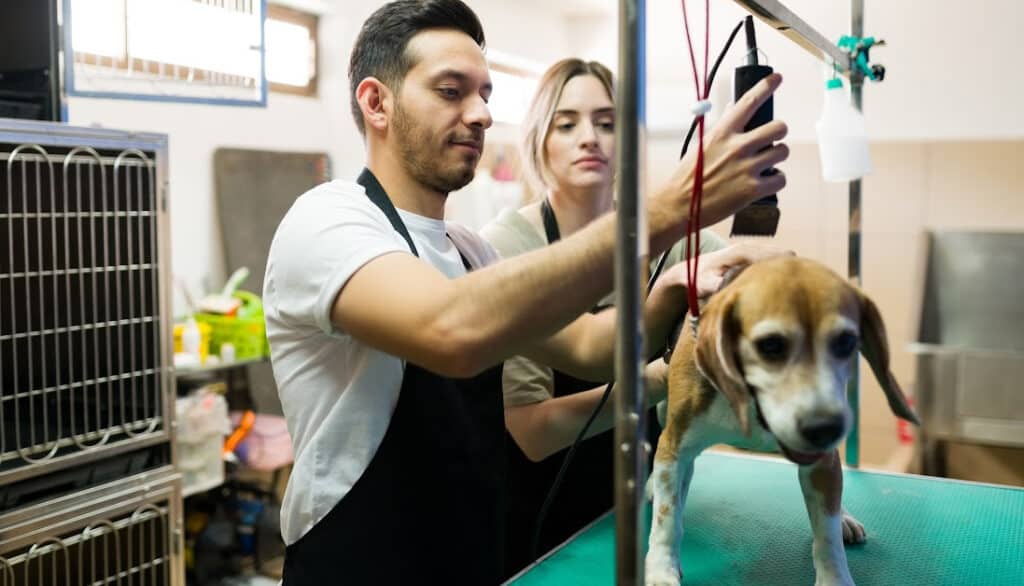
Features to look for in a dog clipper
To select the perfect dog clipper for grooming, it is crucial to consider different features. Here are the essential features to look for when choosing a dog clipper:
- Blade Quality
- Power source and Type of motor
- Noise level
- Corded vs Cordless
- Weight and Ergonomics of Clipper
- Versatility of Blades and Comb attachments
The blade quality is a top priority as it determines how effectively the fur will be trimmed. The power source and motors affect the overall performance of the clipper; hence they need to be considered. Furthermore, noise level can impact pet’s attitude towards grooming sessions, making corded vs cordless operation an essential consideration. Moreover, weight and ergonomic design have an impact on your comfort during the grooming process. Lastly, versatility in blades size options and comb attachments allows you to groom your dog’s fur precisely.
It is crucial to note that there are many other technical features that may differ between clippers depending on personal preferences or breed-specific requirements; thus consulting with a professional would be wise before making a final decision.
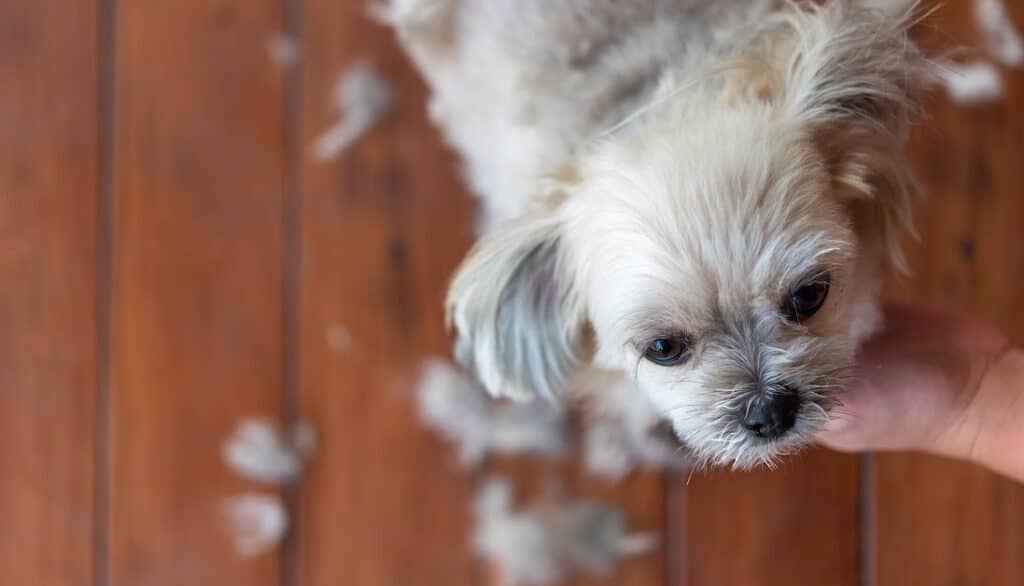
Top 5 Best Clippers for Grooming Dogs
When it comes to grooming our furry friends, finding the best clippers is crucial for a successful and stress-free session. Here’s a rundown of top-performing dog clippers that can make your life easier.
| Clipper Brand | Features | Price Range |
|---|---|---|
| Andis Pro-Animal Clipper | Cool-running motor, detachable blades, 5-speed settings | $150-$200 |
| Oster A5 Turbo 2-Speed Clipper | Powerful, great for heavily matted dogs & thick coats, 2-speed settings | $120-$160 |
| Shernbao Professional Animal Grooming Clipper | Lightweight, quiet and cordless operation, adjustable blade sizes, good for sensitive dogs | $130-$170 |
| Wahl Bravura Lithium Ion Pet Clipper Kit | Cordless operation with low vibration and noise, 5-in-1 blade system for versatile grooming | $150-$190 |
| Andis Excel Pro-Animal 5-Speed Detachable Blade Clipper | Specially designed for heavy use, easy-to-change blade system with 5 speed settings | $220-$260 |
All of these clippers have unique features that make them stand out from one another. While some are corded, others are cordless. Some come with adjustable blade sizes while some offer multi-speed options. It all depends on your dog’s needs and your preferences.
It’s important to note that while expensive clippers may seem like the best option, they may not necessarily be the right fit for your dog. Consider your dog’s coat type, grooming needs and temperament before making a final decision. With the right tools and approach, grooming can become an enjoyable bonding experience for you and your furry companion.
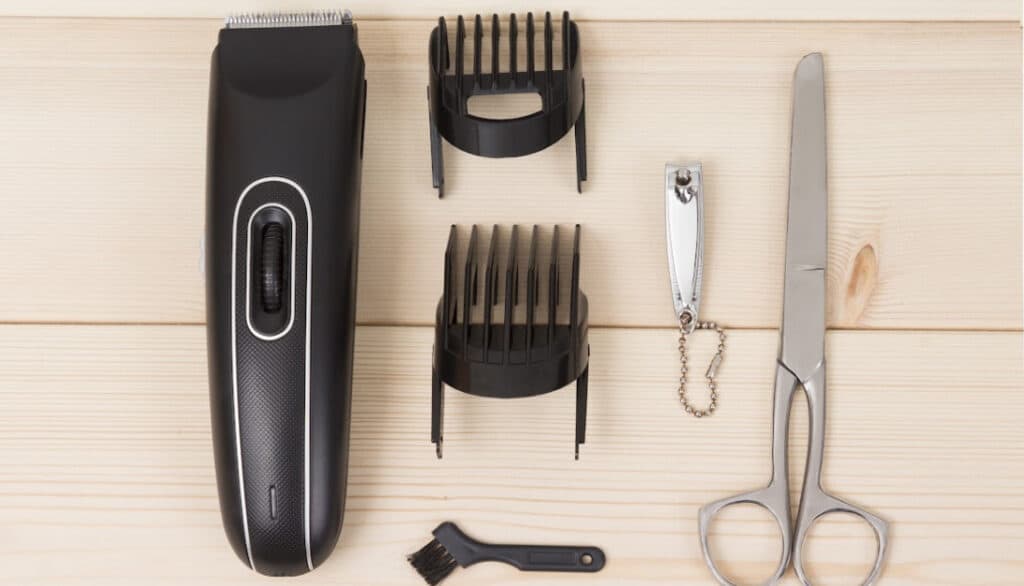
Dog Clipper Maintenance
To maintain your dog clippers, with importance as the key factor, follow the steps to clean and maintain them. Avoid common mistakes when cleaning. In this section, we will introduce the importance of maintaining your dog clippers and how to keep them clean in order to maintain their longevity. Also, we will brief you on the common mistakes you should avoid while cleaning your dog clippers.
Importance of maintaining dog clippers
Maintaining dog clippers is integral to keeping them in optimal condition. Dog clipper maintenance helps to ensure safe and effective grooming while prolonging the device’s lifespan. Neglecting maintenance could result in poor performance, compromised pet safety, and increased repair costs.
Why is Dog Clipper Maintenance Important?
- Regular maintenance of your dog clipper ensures that the blade remains sharp, reducing the risk of nicks or cuts.
- Routine cleaning and oiling reduces friction between parts, ensuring a smoother operation with less heat buildup.
- Replacing worn-out parts, such as blades or motors, and fixing defects before they worsen can save you money in the long run.
Proper maintenance ensures that your dog clipper is always ready for use when you need it. Skipping routine care could lead to a malfunction mid-grooming session, causing distress to both you and your pet.
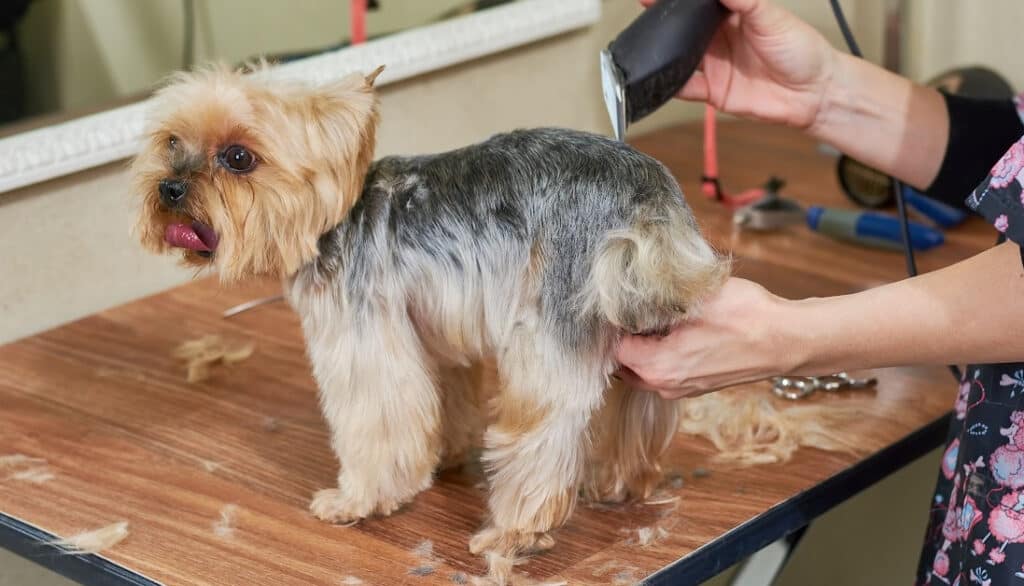
Maintaining Your Dog Clipper: Best Practices
To keep your dog clipper in good shape, take time to clean it after every use. Use specialized tools to remove hair from under the blade guard, then wipe off any remaining debris using a soft cloth. Apply a drop of oil onto the blade pivot point before storing it away using a protective cover.
Keeping your dog clipper well-maintained is key for optimal function while maximizing its lifespan. By performing regular maintenance like cleaning and oiling after every use and replacements as needed, you’ll ensure that your furry friend receives safe yet efficient grooming sessions every time.
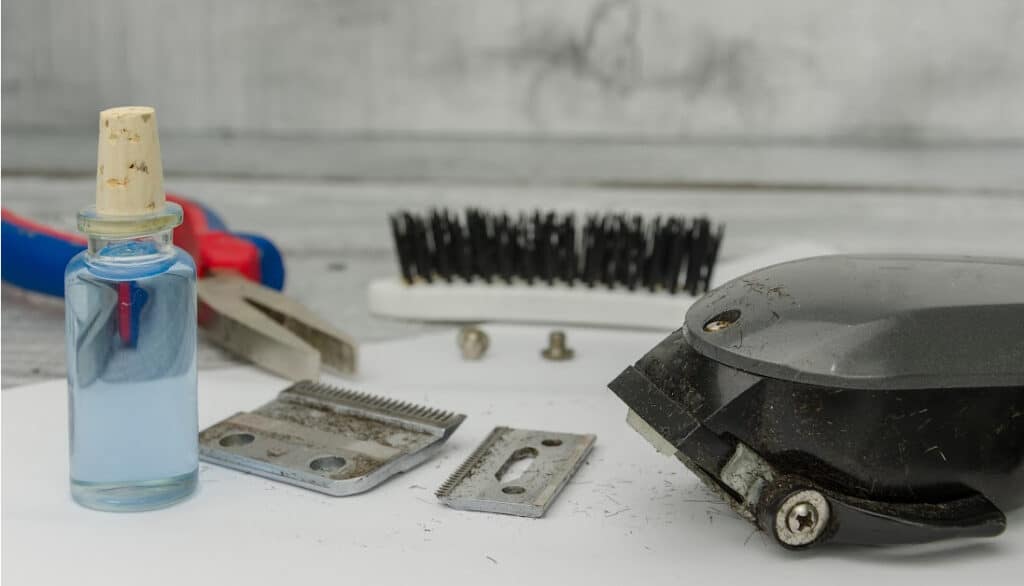
Steps to clean and maintain dog clippers
Proper maintenance of dog clippers is mandatory to ensure that your pet’s grooming is done impeccably. It is essential to keep the clippers clean and well-maintained to avoid infections and injuries. Let’s understand the necessary steps to undertake for cleaning and maintaining dog clippers.
- Preparation: Before starting cleaning, always unplug the clipper and ensure that it has cooled down.
- Cleaning Blades: Remove the blades and clean any hair or debris attached to them using a small brush. Ensure that you do not lose any screws while taking off the blades. Then, soak the blades in a professional oil solution overnight to remove any rust or bacteria.
- Nose Hair Trimmer Removal – If your clipper has a nose hair trimmer attached, remove it carefully. Wipe it down with a soft damp cloth before reattaching it.
- Cleaning Clipper Body: Use a dry cloth to wipe away any loose hair on the clipper body, including areas around vents or holes as they may affect airflow. Then use an approved clipper cleaning spray to rinse and sterilize all surfaces of the clipper.
To prevent damage to fur and skin when clipping your pet, maintain blade sharpness by sharpening them every few months with a professional sharpening machine. Always replace damaged parts with authentic ones offered by authorized dealerships or manufacturers who assure quality products.
Regularly scheduled cleanings will enhance their longevity lifespan and guarantee excellent performance for future grooming sessions. Keep this guide handy, clean your clippers various times standardly during its life cycle, increased during dusty periods(approximately twice per week), followed by lubrication services(using proper oils).
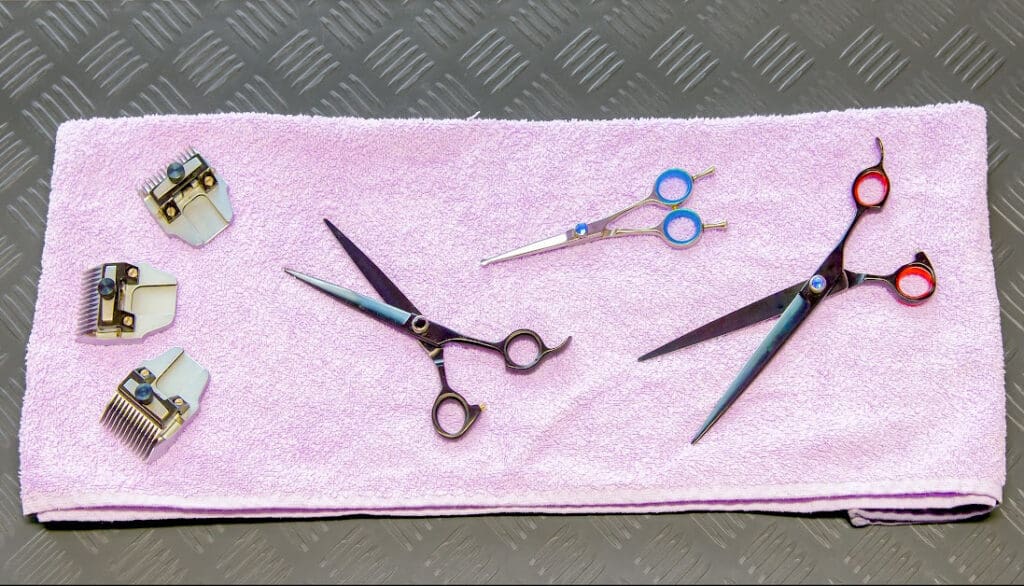
Common mistakes to avoid when cleaning dog clippers
Cleaning your dog clippers is important and should be done regularly to maintain their effectiveness. However, there are certain misconceptions that need to be avoided in the process of cleaning these tools to keep them in optimal condition.
To help you steer clear of these mistakes, here’s a four-step guide on the right way to clean your dog clippers:
- First and foremost, start by turning off and unplugging the clippers. This ensures your safety and prevents any damage.
- Remove the blades from the clipper – use a screwdriver or other appropriate tool for this – and brush off any excess hair or debris with a small brush or toothbrush.
- Cleanse each piece thoroughly using blade wash, cleaning solution or warm soapy water. Dry all pieces completely before reassembling everything back together.
- Finally, it’s important to lubricate your blades after cleaning- this helps prevent rusting and keeps them working at their peak performance levels
It’s best not to soak your clippers in water as this can cause internal damage. Rubbing alcohol is also discouraged as it dries out the blade teeth. Instead make use of an adequate cleaning solution.
A key example of a semantic variation would be ‘Important Dog Clipper Cleaning Tips’. By understanding common trends associated with clipper maintenance, one can avoid several misgivings regarding vibration which leads to broken parts as well as loss tolerance during cutting procedures. By following strict outlined steps of switching off appliances, brushing excess hair, etc., maintenance efforts become easier & promote better efficiency with pet grooming processes involved.

Professional Grooming Vs DIY Grooming
To make an informed decision between professional and DIY grooming, consider the pros and cons of each option, along with key factors that may influence your choice. Professional dog grooming has its benefits, but it can also be expensive and inconvenient. On the other hand, DIY grooming can save you money, but requires more time and effort on your part. In this section, we’ll explore the advantages and disadvantages of both approaches, along with important considerations to help you choose the best one for you and your furry best friend.
Pros and cons of professional dog grooming
Professional grooming for dogs: What are the benefits and drawbacks?
Grooming plays a vital role in maintaining a dog’s health and hygiene. While many pet parents prefer to groom their furry friends at home, some prefer professional services. Professional grooming has both advantages and disadvantages.
Pros of professional dog grooming:
| Pros of Professional Dog Grooming | |
|---|---|
| 1 | Hygiene Maintenance: Professionals have the tools and skills necessary to clean dogs’ ears, teeth, and coat effectively, leading to better overall hygiene. |
| 2 | Nail Trimming: Trimming a dog’s nails can be challenging for many owners. Professional groomers know how to do this without causing any discomfort or harm. |
| 3 | Proper Grooming Equipment: They have access to high-quality grooming equipment, which makes the grooming process more efficient and effective. |
| 4 | Coat Care: Regular professional grooming can help keep the dog’s coat in good condition, reducing shedding and potential skin issues. |
| 5 | Parasite Detection: Professionals can spot early signs of fleas, ticks, or other skin infections and guide owners to appropriate treatments. |
| 6 | Expert Handling: Groomers have the expertise to handle dogs of all breeds and temperaments, ensuring a stress-free experience for the dog. |
| 7 | Aesthetics: Professional groomers can make your dog look its best, which is especially important if your dog participates in shows. |
| 8 | Early Detection of Health Issues: Groomers may notice abnormalities such as lumps, rashes, or skin discoloration, which could be signs of underlying health problems. |
| 9 | Saves Time and Effort: For busy pet owners, having a professional take care of grooming can save a lot of time and effort. |
| 10 | Reduced Risk of Injury: Professionals have been trained to groom without causing cuts or irritation to the skin, reducing the risk of injury during grooming. |
Cons of professional dog grooming:
| Cons of Professional Dog Grooming | |
|---|---|
| 1 | Cost: Professional grooming services can be expensive, especially for large breeds or dogs with specific grooming needs. |
| 2 | Stress for the Dog: Some dogs might find the grooming process stressful, especially when handled by strangers in a new environment. |
| 3 | Risk of Injury: Although rare, there’s a small risk of injury if the groomer isn’t careful or the dog becomes agitated. |
| 4 | Inconvenience: Scheduling and transportation to grooming appointments can be inconvenient. |
| 5 | Possible Exposure to Diseases: If the grooming salon doesn’t maintain strict hygiene standards, there’s a risk of dogs catching diseases from other pets. |
| 6 | Incorrect Styling: Not all groomers are skilled in styling all breeds. Incorrect grooming can lead to discomfort or even health issues for some dogs. |
If you opt for professional dog grooming, it’s worth considering if the benefits outweigh any potential drawbacks before making your decision. While there are certainly advantages like the convenience of dropping off your pup for a full grooming session that includes pampering and snuggles for a few hours to style while you get some errands done it’s important to note the time and costs in addition to any potential effects on the bond between you and your pet.

Pros and cons of DIY dog grooming
DIY Dog Grooming – Weighing the Pros and Cons
Grooming your furry friend at home may seem like a good idea, but is it worth it? Let’s take a look at the pros and cons of DIY dog grooming.
- Pros:
- Saves money
- Bonding experience
- Familiarity with your pet’s body and behavior
- Avoids stress caused by unfamiliar surroundings and people
- Cons:
- Possible injury due to lack of experience or tools
- Might not achieve desired results in terms of appearance and hygiene level
- Missed health issues or underlying problems
- Takes up time and effort for cleaning up after the grooming session
It is important to remember that certain breeds require special grooming needs, which may be out of your reach to meet. All in all, weighing the pros and cons of DIY dog grooming can help you determine whether it’s worth trying or leaving for a professional groomer.
Factors to consider when choosing between professional and DIY dog grooming
When deciding between grooming your dog at home or seeking professional services, various factors need to be taken into account. Carefully reviewing each aspect before choosing can save time and expenses.
- Cost: While DIY grooming may seem less expensive, purchasing quality equipment can become a significant expense over time. Professional grooming services often provide necessary gear and are usually cost-effective in the long run.
- Expertise: Professional groomers have training and experience that allows them to handle dogs of different breeds and temperaments. On the other hand, an owner may not have adequate knowledge or tools to cater to their dog’s specific needs.
- Convenience: Time constraints may lead one to prefer either of the options. While home grooming can fit into a busy schedule, professional grooming often offers flexible schedules that suit pet owners’ needs.
It is crucial to consider all aspects carefully before making a decision as no one method suits every dog’s needs. Keep in mind the breed, age, health condition of your pet, your availability, and budget when deciding which option suits both you and your four-legged friend best.
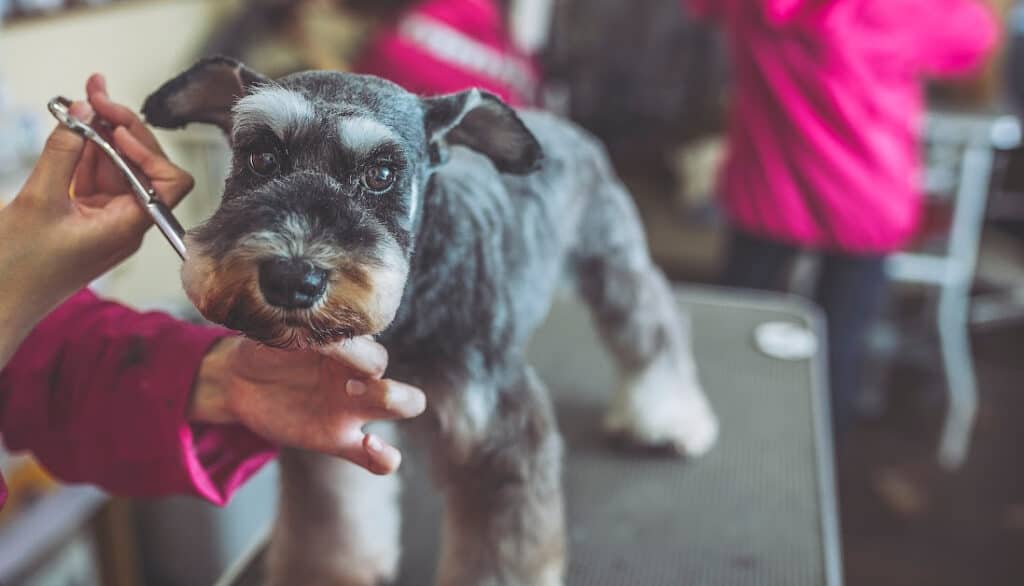
Tips for Grooming Dogs at Home
To achieve professional level grooming for your dog at home, follow these tips for grooming dogs at home with the focus on pre-grooming preparation, techniques to help your furry friend relax during the grooming process, and tips for ensuring excellent results. Prepare your dog for grooming, relax them during the process, and get salon-level results at home with these techniques.
Importance of pre-grooming preparation
Grooming your dog at home can be an enjoyable and rewarding experience for both you and your pet, but it requires pre-grooming preparation. Proper pre-grooming preparation ensures that you have all of the tools and equipment you need, and it also makes the grooming process more efficient. It is essential to prepare before starting any grooming activity with your furry friend.
- Preparing yourself mentally and physically for the activity
- Gathering all necessary grooming tools
- Creating a safe environment for your doggy
- Maintaining an organized grooming area to avoid any confusion or interruptions during the grooming session.
It is crucial to take extra care when preparing for dog grooming because a lack of enough attention could pose risks such as injury from sharp dog grooming scissors or clippers that may cause cuts, scratches or nicks on their skin. Prioritize creating a comfortable environment that your dog will be relaxed in during the grooming activity. It’s best to consider investing in soft towels, a non-slip bathing mat, quality shampoo and conditioner to keep him calm while you are carrying out this duty. Remember to avoid stressful events such as using loud music or forcing water down their throat.
Incorporate these tips into your pre-grooming routine to ensure when it’s time to groom Fido, he is relaxed enjoying the experience while keeping him looking stylish and hygienic without risking causing pains due to lack of adequate preparation.
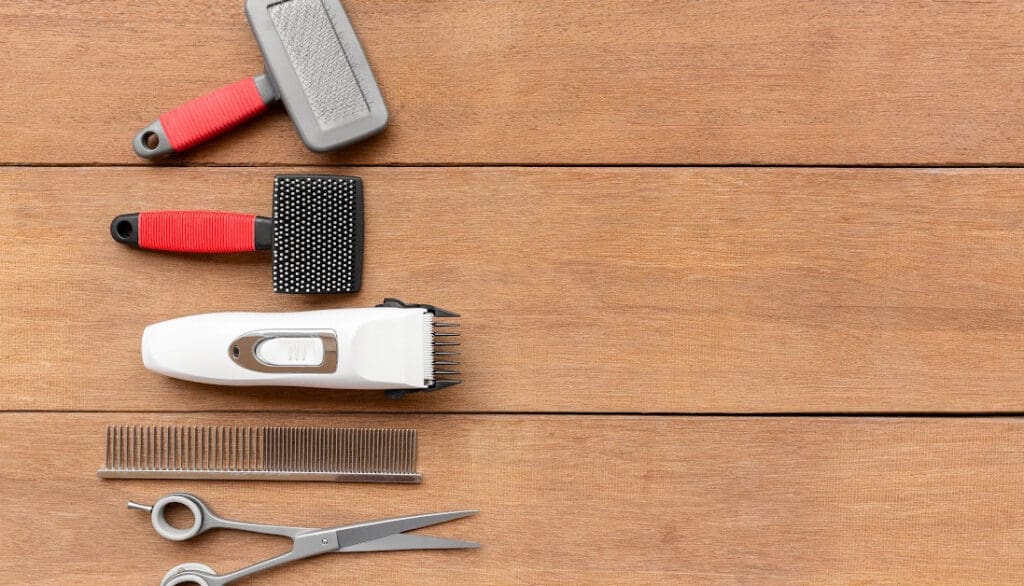
Techniques to make grooming less stressful for dogs
To ensure that your dog undergoes grooming procedures without any stress, it is essential to use specific techniques. These techniques will help put your dog at ease and enable you to groom your furry friend effectively.
- Introduce Grooming Techniques Gradually: It is critical to introduce your dog to grooming gradually. Try isolating one part of their body and begin by grooming that area before moving on to the others.
- Reward Them for Good Behavior: Positive reinforcement goes a long way in making grooming less stressful for dogs. Reward them with treats when they behave well during their grooming sessions.
- Use Safe and Effective Products: Ensure you choose products that are suitable for your dog’s age, breed, and skin type. Also, opt for high-quality tools that are comfortable and safe for your pooch.
- Make Grooming Sessions Shorter: Lengthy grooming sessions can be stressful for dogs; keep them short but frequent. Establish a regular routine so that the more often you groom your pet, the more relaxed they’ll become.
One of the most common mistakes pet owners make while grooming their dogs is using aggressive methods such as yelling or hitting when things don’t go smoothly. These techniques may have negative psychological effects on dogs, damaging trust and ultimately causing more stress in future grooming sessions.
By following these tips, dog owners can reduce their pets’ stress levels during the grooming process, creating a bond between pet and owner while maintaining optimal coat health.
Tips for achieving good results when grooming dogs at home
Grooming a dog at home can be challenging without adequate knowledge and skills. Here are six tips to achieve excellent results when grooming your furry friend:
- Choose the right grooming tools for your dog’s coat type.
- Bathe your dog with quality shampoo and conditioner, ensuring the water is at an appropriate temperature.
- Trim your dog’s nails regularly to avoid overgrowth and discomfort.
- Clean your dog’s ears and teeth often to prevent infections and dental problems.
- Brush your dog’s coat frequently to remove dirt, tangles, and mats.
- Be gentle with your dog throughout the grooming process to avoid injuries or stress.
Aside from these tips, make sure to seek professional help if you encounter any difficulty in grooming or notice any unusual symptoms on your pet. Consistency and patience are also crucial factors that contribute to achieving good results in home grooming.
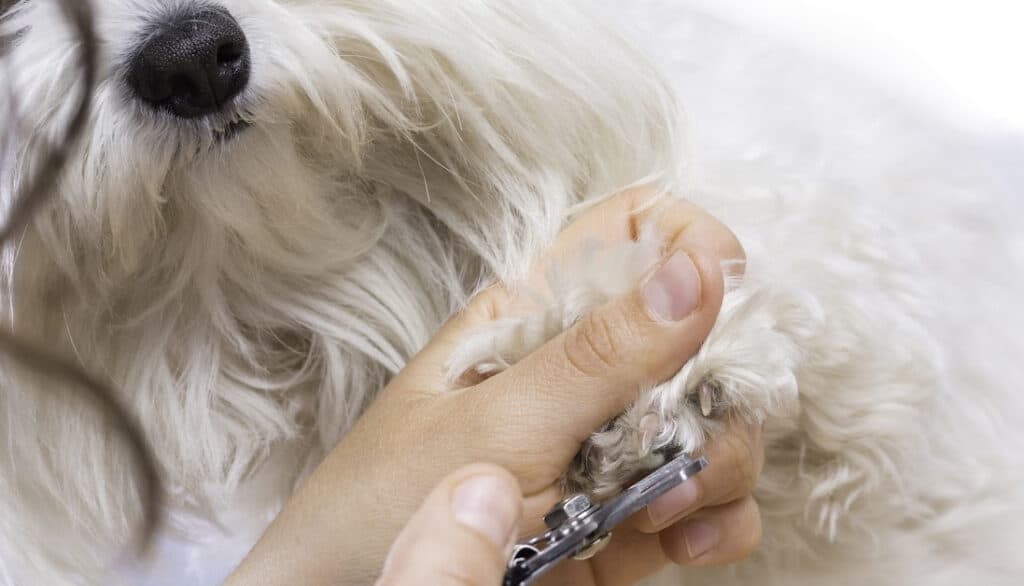
Conclusion
To wrap up the topic of using human clippers on dogs, it’s important to reflect on the key points covered in this article. In summary, we discussed the pros and cons of using human clippers, how to choose the right type, and the precautions to take while using them. In final thoughts, we’ll provide some tips for best clipping practices and leave you with the knowledge to make an informed decision about using human clippers on your furry friend.
Summary of key points
Our analysis of the topic at hand brings forth a few key takeaways that merit attention.
- It is important to realise the significance of the subject at hand and its impact on the readers.
- By assessing various points of view, we can see that there are valid arguments supporting both sides of the debate.
- An examination of real-world examples sheds light on how these principles operate in reality.
- It is crucial to understand the gravity of our discussion.
- There are compelling arguments for both sides.
- Real-world examples illustrate how these ideas materialise.
Final thoughts on using human clippers on dogs and best clipping practices
When using human clippers on dogs, it is important to keep in mind the best practices for clipping to avoid causing injury. Utilizing clippers designed specifically for dogs can be a safer option, but if using human clippers, be sure to take precautions such as keeping the blades sharp and properly lubricated. Avoiding sensitive areas and taking frequent breaks can also help prevent accidents.
Additionally, it’s important not to rush through the clipping process as this could lead to mistakes or overlooking areas that require attention. Taking time to carefully clip your dog can result in a better grooming job overall.
Lastly, understanding your dog’s specific coat type and needs can help determine the most appropriate clipping technique. Whether your dog has short or long hair, a regular grooming routine that includes dematting and bathing can make the clipping process easier and more effective.
Ultimately, prioritizing safety, taking your time, and understanding your dog’s unique needs are key factors in successful at-home grooming with human clippers.
Frequently Asked Questions
Yes, you can use human clippers on dogs. However, the type of clipper you use will depend on the type of coat your dog has and the grooming job that needs to be done.
The best type of clipper to use on dogs depends on their coat. For thick or double-coated breeds, a heavy-duty clipper with a powerful motor is best. For shorter or finer coats, a lightweight clipper with a smaller motor will work well.
No, it is not recommended to use a beard trimmer on your dog. Human beard trimmers are not designed for the thick and coarse hair of dogs and can cause discomfort and potential harm to your pet.
You should choose a clipper blade based on the length and thickness of your dog’s coat. The lower the blade number, the shorter the cut. Shorter coats, use blades 10 or 15. For medium-length coats, use blades 4, 5, or 7. For longer coats, use blades 3, 3 ¾, or 5F.
It is not recommended to use clippers on your dog’s sensitive areas such as their genitals or face. These areas require special attention and may require scissors or hand trimming.
To maintain your dog clippers, you should clean the blades after each use and oil them to prevent rusting. You should also regularly check the blades for dullness and have them sharpened or replaced when necessary.
